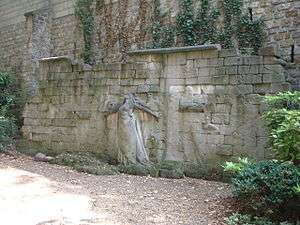Communards' Wall

The Communards’ Wall (Mur des Fédérés) at the Père Lachaise cemetery is where, on May 28, 1871, one-hundred and forty-seven fédérés, combatants of the Paris Commune, were shot and thrown in an open trench at the foot of the wall.[1] To the French left, especially socialists and communists, the wall became the symbol of the people's struggle for their liberty and ideals. Many leaders of the French Communist Party, especially those involved in the French Resistance, are buried nearby.
The Père Lachaise cemetery was established in May 1804 on a land owned by the Jesuits for centuries, and where Père ("Father") Lachaise, confessor of Louis XIV, lived the latter part of his life. Cemetery of the aristocracy in the 19th century, it also received the remains of famous people from previous eras. During the spring of 1871 the last of the combatants of the Commune entrenched themselves in the cemetery. The Armée versaillaise, which was summoned to suppress the Commune, had control over the area towards the end of the afternoon of May 28th, and shot all of the prisoners against the wall.
The massacre of the Communards did not put an end to the repression. During the fighting between 20,000 and 35,000 deaths, and more than 43,000 prisoners were taken; afterwards, a military court pronounced about a hundred death sentences, more than 13,000 prison sentences, and close to 4,000 deportations to New Caledonia.

The memory of the Commune remained engraved in the people's memory, especially within the workers' movement which regenerated itself in a few years time. The first march before the Wall, at the call of Jules Guesde, took place on May 23, 1880, two months before the Communards' Amnesty: 25,000 people, a symbolic "immortal" red rose in their buttonholes, stood up against police forces. From that time on, this "ascent to the Wall", punctuated French labor force political history. Every year since 1880, the organizations of the French left have held a demonstration in this symbolic place during the last week of May. Jean Jaurès -- although a child in the provinces at the time of the Commune, hence with no direct memory —- made the ascent several times, accompanied by Édouard Vaillant, Jean Allemane, and by thousands of socialist, syndicalist, and anarchist militants.
The record-breaking demonstration took place on May 24, 1936: 600,000 people, led by Léon Blum and Maurice Thorez, right in the middle of the strikers movement, several weeks after the start of the Popular Front.
"Tombe sans croix et sans chapelle, sans lys d'or, sans vitraux d'azur, quand le peuple en parle, il l'appelle le Mur." - Jules Jouy
"Tomb without a cross or chapel, or golden lilies, or sky blue church windows, when the people talk about it, they call it The Wall." - Jules Jouy
See also
References
- ↑ Steves, Rick; Smith, Steve; Openshaw, Gene (10 October 2007). Rick Steves' Paris 2008. Avalon Travel. p. 316. ISBN 978-1-56691-863-3. Retrieved 15 October 2010.
Coordinates: 48°51′35″N 2°23′59″E / 48.85972°N 2.39972°E